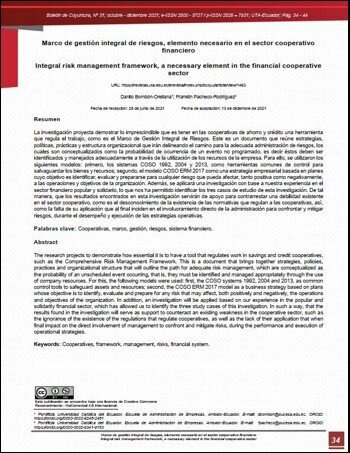Integral risk management framework, a necessary element in the financial cooperative sector
Main Article Content
Abstract
The research projects to demonstrate how essential it is to have a tool that regulates work in savings and credit cooperatives, such as the Comprehensive Risk Management Framework. This is a document that brings together strategies, policies, practices and organizational structure that will outline the path for adequate risk management, which are conceptualized as the probability of an unscheduled event occurring, that is, they must be identified and managed appropriately. through the use of company resources. For this, the following models were used: first, the COSO systems 1992, 2004 and 2013, as common control tools to safeguard assets and resources; second, the COSO ERM 2017 model as a business strategy based on plans whose objective is to identify, evaluate and prepare for any risk that may affect, both positively and negatively, the operations and objectives of the organization. In addition, an investigation will be applied based on our experience in the popular and solidarity financial sector, which has allowed us to identify the three study cases of this investigation. In such a way, that the results found in the investigation will serve as support to counteract an existing weakness in the cooperative sector, such as the ignorance of the existence of the regulations that regulate cooperatives, as well as the lack of their application that when final impact on the direct involvement of management to confront and mitigate risks, during the performance and execution of operational strategies.
URL: https://revistas.uta.edu.ec/erevista/index.php/bcoyu/article/view/1463
Downloads
Article Details

This work is licensed under a Creative Commons Attribution-NonCommercial 4.0 International License.
![]()
The publications of the Boletín de Coyuntura are licensed under a Creative Commons Attribution-NonCommercial 4.0 International License (CC BY-NC 4.0). The Universidad Técnica de Ambato retains the copyright of the published works, and favors and allows the reuse of these, as long as: the authorship and original source of publication is cited, and they are not used for commercial or onerous purposes. The intellectual property of the published articles belongs to the authors.
References
Carvajal, A (2015). Aplicación de la herramienta integrada de control interno y administración de riesgos, enmarcada en buen gobierno corporativo para pymes en Colombia. Bogotá, Colombia: Editorial U. Externado de Colombia
Diccionario de la Lengua Española (2014). Edición del Tricentenario. Madrid. España.
Enterprise Risk Management Integrating with Strategy and Performance. (2017). Committee of Sponsoring Organizations of the Treadway Commission. https://www.coso.org/Documents/2017-COSO-ERM-Integrating-with-Strategy-and-Performance-Executive-Summary.pdf
Estupiñán, R. (2006). Control interno y fraudes: con base a los ciclos transaccionales: análisis de informe COSO I y II (Segunda Edición). Bogotá, Colombia. Ecoe Ediciones. https://elibro.puce.elogim.com/es/ereader/puce/69012?page=18.
Estupiñán, R. (2015). Administración de Riesgos E.R.M. y la Auditoría Interna. Bogotá, Colombia. Ecoe Ediciones. https://books.google.com.ec/books?id=psK4DQAAQBAJ&printsec=frontcover&dq=libro:+Los+Principios+de+la+Auditor%C3%ADa+Operativa&hl=es419&sa=X&ved=0ahUKEwiv8YSKhYbnAhUowlkKHdBEB404ChDoAQhWMAc#v=onepage&q&f=false
Estupiñán, R. (2015). Control interno y fraudes: análisis de informe COSO I, II y III con base en los ciclos transaccionales. Bogotá, Colombia. Ecoe Ediciones. ProQuest Ebook Centra. http://ebookcentral.proquest.com/lib/pucesp/detail.action?docID=4422272.
Estupiñán, R. (2016). Control interno y fraudes: análisis de informe COSO I, II y III con base en los ciclos transaccionales. Bogotá, Colombia. Ecoe Ediciones. https://elibro.puce.elogim.com/es/ereader/puce/70433?page=65.
Junta de Regulación Monetaria Financiera. (2017). Resolución No. 380-2017-F
Junta de Regulación Monetaria Financiera. (2015). Resolución No. 128-2015-F
Mantilla, K. (2016). Gestión de riesgo empresarial: Evaluación y mejoramiento del control interno de fundaciones. Estudio de caso. Quito, Ecuador: Abya Yala. Universidad Politécnica Salesiana. https://dspace.ups.edu.ec/bitstream/123456789/12825/1/GESTION%20DE%20RIESGO%20EMPRESARIAL.pdf
Mantilla, S. (2013). Auditoría del control Interno. Bogotá Colombia. Ecoe Ediciones Ltda. Tercera edición
Ministerio de Finanzas. (2017). Metodología para la gestión integral de riesgos. Recuperado el 30 de 03 de 2017. https://www.finanzas.gob.ec/wp-content/uploads/downloads/2017/04/Metodolog%C3%ADa-para-la-Gesti%C3%B3n-de-Riesgos-30-03-17.pdf
Norma ISO 31000 versión 2009: Gestión de Riesgos – Principios y Guía.
http://gestion-calidad.com/wp-content/uploads/2016/09/iso_31000_2009_gestion_de_riesgos.pdf
Pereira, P. (2019). Control interno en las empresas. Instituto Mexicano de Contadores Públicos. https://elibro.puce.elogim.com/es/ereader/puce/124953?page=20.
Superintendencia de Bancos. (2017). Resolución No. SB-2017-602. https://www.superbancos.gob.ec/bancos/wp-content/uploads/downloads/2017/10/resol_SB-2017-602.pdf
Superintendencia de Economía Popular y Solidaria. (2018). Resolución No. SEPS-IGT-IR-IGJ-2018-0284
Tamayo, M., & Gonzalez, D. (2020). La gestión de riesgos: herramienta estratégica de gestión empresarial. Cienfuegos, Cuba: Editorial Universo Sur.
Tapia, C. (2019). Fundamentos de auditoría. México, Ciudad de México. Instituto Mexicano de Contadores Públicos, A.C.


